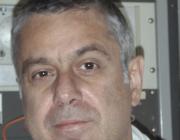Abstract:
On 10 April 2007, three moderate earthquakes with Mw=4.9–5.1 occurred in the vicinity of Trichonis Lake (W. Greece). A local network composed of 12 three-component digital seismographs was installed in the epicentral area and recorded more than 1600 events. The double-difference algorithm HYPODD, incorporating both catalog and waveform cross-correlation differential travel-time data, was applied for the successful relocation of 1490 earthquakes. The latter led to the distinction of a main NW-SE trending and NE-dipping zone, as well as of three neighboring faults; a conjugate NW-SE striking and SW-dipping marginal fault mapped along the northeastern flanks of the lake; a E-W trending and south-dipping low-angle normal fault, possibly related to the major Agrinio Fault Zone (AFZ), parallel to the northern bank of the lake; a NE-SW striking and NW-dipping normal fault, likely related to a segment of the active Evinos fault, located south of the lake. Calculation of the Coulomb stress induced by the combination of the 1975 Mw=6.0 event and the three largest events of 10 April 2007 on the inferred structures, reveals that most of the seismicity lies within the “stress-loaded” region, except for the westernmost activity, which probably belongs to the deep part of the AFZ. A total of 178 reliable focal mechanisms were determined by regional and local body-wave modeling (5 largest events) and P-wave first motion polarity data. The types of the obtained focal mechanisms are predominantly normal and strike-slip, however, numerous earthquakes were found to exhibit reverse faulting. Inversion of focal mechanism data showed that the prevailing principal horizontal component σ3 is quite homogeneous throughout the activated area with a roughly NW-SE trend, parallel to the strike of the Hellenides. On the contrary, the compressional field σ1 appears in two patterns: NE-SW trending onshore and NW-SE trending beneath the lake. This apparent rotation of σ1 by 90° reveals a complex system enclosed by the suggested NW-SE trending antithetic faults in depths between 7 and 9km. The calculated stress ratios beneath the lake imply that vertical forces are close to the overburden pressure. The overall inferred stress pattern is rather linked to topographic variations, locally imposing increase or decrease of the vertical forces. The presence of the water in the lake possibly plays an additional important role, penetrating through the bedrock, reducing the friction coefficient, while the pore pressure and, consequently, the effective stress increase. Thus, shearing along mature fractures is enhanced, likely yielding the observed diversity.
Publisher's Version

